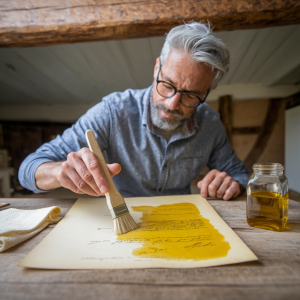Ironing a document between wax paper is a poor man’s way of lamination
Poor Man’s Document Preservation: How to Waterproof Important Documents Without Lamination
If you’ve ever watched rain turn your emergency documents into an abstract watercolor painting, you know the importance of waterproofing your papers. But what if I told you that you don’t need expensive lamination equipment or even those office supply store services to protect your vital documents? Our great-grandparents knew a thing or two about preserving important papers, and today we’re going to explore those forgotten methods that work just as well as modern solutions – maybe even better.
Let’s start with what might sound like your grandmother’s baking supplies: wax paper. But we’re not making cookies here; we’re creating water-resistant document protection that would make any prepper proud. This method has been used for centuries to preserve everything from maps to marriage certificates, and it’s surprisingly effective. The process is simple, but like most things worth doing, it requires patience and attention to detail.
To wax-protect your documents, you’ll need wax paper, an iron set to low heat (no steam!), and a steady hand. Place your document between two sheets of wax paper, then gently iron over the top sheet. The key word here is ‘gently’ – we’re not trying to press your lucky suit here. The heat slowly melts the wax into the paper fibers, creating a water-resistant barrier that can last for years. Work from the center outward to avoid creating air bubbles, kind of like applying a screen protector to your phone, but with more meaningful consequences than a few annoying bubbles.

Wax paper-the poor man’s lamination method
The oil paper technique is another traditional method that’s stood the test of time. This isn’t about dunking your birth certificate in olive oil – we’re talking about a specific process that was once used by sailors to protect their maps at sea. You’ll need linseed oil (available at any hardware store) and a well-ventilated space because this stuff smells like your uncle’s old paint collection. The process involves carefully brushing a thin layer of oil onto the paper, allowing it to penetrate the fibers, then letting it dry completely. The result is a translucent, water-resistant document that maintains its flexibility.
Now, for those who want a more modern approach without the expense of lamination, let’s talk about the double-bag method with silica gel packets – those little packets that come with everything from beef jerky to new shoes. This method is particularly effective for long-term storage and doesn’t alter your documents in any way. Start with a high-quality freezer bag (don’t skimp here – store brand bags can be useless). Place your document inside with a couple of silica gel packets, squeeze out as much air as possible, seal it, then place this bag inside another freezer bag with the seal facing the opposite direction. Think of it as creating a tiny, waterproof vault for your papers.
Different documents require different approaches. Photographs, for instance, don’t play well with the oil method but do beautifully with the wax paper technique. Birth certificates and other official documents with raised seals or special security features should only be protected using the double-bag method – anything else might alter them in ways that could make them invalid when you need them most.
Storage considerations are crucial regardless of which method you choose. Keep your protected documents in a cool, dark place – think wine cellar conditions, not that cabinet above your stove. UV light is not your friend here; it can break down even the best protection over time. For extra security, consider creating a document go-bag that includes copies protected by different methods. It’s like having backup plans for your backup plans.
Let’s talk about what can go wrong, because knowing potential pitfalls is as important as knowing the techniques. With the wax method, too much heat can turn your important papers into modern art – and not the valuable kind. The oil technique requires patience; rushing the drying process can leave you with a greasy mess that attracts dust like a black car in pollen season. And with the double-bag method, forgetting to check and replace silica packets regularly is like forgetting to change your smoke detector batteries – you won’t know it’s failed until it’s too late.
Testing is crucial. Before you try any of these methods on important documents, practice on copies. Think of it like learning to cook – you don’t want your first attempt to be on Thanksgiving day with the whole family watching. Once you’ve mastered the technique, create samples and test them under different conditions. Sprinkle some water on them, leave them in a humid environment, see how they hold up. It’s like crash-testing your document protection system before you need it.

Using linseed oil on paper to waterproof it
For truly critical documents – the ones that would make your life significantly more difficult if lost – consider using multiple protection methods in layers. Start with the double-bag method, then store those bags in a larger wax-paper protected envelope. It might seem like overkill, but when you’re trying to prove your identity during an emergency, you’ll be glad you went the extra mile.
Remember, the goal isn’t just to protect against water – it’s to ensure your important documents survive whatever life throws at them. Think of it as creating a time capsule that you hope to never need but will be invaluable if you do. Whether it’s a burst pipe, a leaky bug-out bag, or that time your toddler decided to turn the living room into a water park, properly protected documents can mean the difference between a minor inconvenience and a major headache.
















